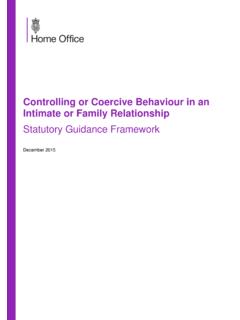Transcription of Practical Strategies for Culturally Competent Evaluation
1 Practical Strategies for Culturally Competent Evaluation Evaluation GUIDE. Acknowledgments This guide was developed by the Centers for Disease Control and Prevention (CDC) in a collaborative effort between the Division for Heart Disease and Stroke Prevention's Applied Research and Evaluation Branch and the Division of Environmental Hazards and Health Effects' Air Pollution and Respiratory Health Branch, National Asthma Control Program. The authors (Derrick Gervin, Robin Kuwahara, Rashon Lane, Sarah Gill, Refilwe Moeti, and Maureen Wilce) wish to thank reviewers Nancy Amerson (Illinois Department of Public Health), Melanie Durley (Georgia Department of Public Health), Michael Sells (Division for Heart Disease and Stroke Prevention, Program Development and Services Branch), and Pam Collins (Division of Environmental Hazards and Health Effects, Air Pollution and Respiratory Health Branch).
2 Suggested Citation Centers for Disease Control and Prevention. Practical Strategies for Culturally Competent Evaluation . Atlanta, GA: US Dept of Health and Human Services; 2014. The findings and conclusions in this report are those of the authors and do not necessarily represent the views of the Centers for Disease Control and Prevention (CDC). Web site addresses of nonfederal organizations are provided solely as a service to our readers. Provision of an address does not constitute an endorsement by the Centers for Disease Control and Prevention (CDC) or the federal government, and none should be inferred. CDC is not responsible for the content of other organizations' Web pages. PURPOSE OF THIS Evaluation GUIDE. CDC provides its funded programs with a wide range of Evaluation resources and guides.
3 State health departments, tribal organizations, communities, and partners working in a variety of public health areas may also find these tools helpful. The resources provide guidance on Evaluation approaches and methods, relevant examples, and additional resources. The guides are intended to aid in skill building on a wide range of Evaluation topics. Practical Strategies for Culturally Competent Evaluation is designed to complement the other Evaluation resources offered by the Division for Heart Disease and Stroke Prevention (DHDSP) and the National Asthma Control Program (NACP) in the Division of Environmental Hazards and Health Effects. P R AC T I C A L S T R AT E G I E S F O R C U LT U R A L LY CO M P E T E N T E VA LUAT I O N | 1.
4 INTRODUCTION. If you talk to a man in a language he understands, that goes to his head. If you talk to him in his language, that goes to his heart. Nelson Mandela, former president of South Africa Purpose CDC's NACP and DHDSP developed this guide as an introduction and resource for CULTURAL state partners to use to promote cultural competence in the Evaluation of public COMPETENCE IS health programs and initiatives. Designed for program staff and evaluators, this guide highlights the prominent role of culture in our work. It provides important Strategies ..a set of congruent for approaching an Evaluation with a critical cultural lens to ensure that Evaluation behaviors, attitudes, efforts have cultural relevance and generate meaningful findings that stakeholders.
5 And policies that individuals who are invested in the program or potentially affected by the Evaluation . come together in a ultimately will value and use. system, agency, or among professionals Throughout this guide, aspects of cultural competence in Evaluation are discussed and enables effective within the context of CDC's Framework for Program Evaluation in Public Health2 to work in cross-cultural highlight opportunities for integrating cultural competence during each of the six situations. 1 steps of the Evaluation process. A list of related resources and tools and an abbreviated version of this guide, titled Program Evaluation Tip Sheet: Integrating Cultural Competence into Evaluation , are available as an appendix. Background According to the Office of Minority Health3 at the Department of Health and Human Services, culture and language may influence Health, healing, and wellness belief systems.
6 Ow patients, consumers, and health care providers perceive illness, disease, H. and their causes. T he behaviors of patients and consumers who are seeking health care and their attitudes toward health care providers. T he delivery of services by providers, who view the world through their own particular values, which can compromise access for patients from other cultures. 2 | P R AC T I C A L S T R AT E G I E S F O R C U LT U R A L LY CO M P E T E N T E VA LUAT I O N. Incorporating cultural competence in public health systems enables professionals to adapt their approaches to benefit individuals and groups from varying cultural backgrounds. Furthermore, improving cultural competence among public health practitioners could help reduce health disparities and improve the quality of care and health for everyone.
7 Over the years, public health professionals have expanded their approaches to preventing disease, as evidenced by the growing number of practice and translation models designed to meet the needs of multiple cultural groups. Incorporating a thoughtful and consistent emphasis on cultural competence when performing all essential public health functions, including Evaluation , creates a necessary foundation for efforts to reduce health disparities. The National Standards for Culturally and Linguistically Appropriate Services in Health and Health Care (the National CLAS. Standards) serve as the cornerstone for advancing health equity through Culturally and linguistically appropriate The Importance of Cultural Competence in Evaluation CDC acknowledges that cultural competence in Evaluation is necessary and important CULTURE IS.
8 For evaluators of all When we conduct an Evaluation , everything we do reflects our own cultural values and perspectives from the Evaluation purpose, The integrated the questions we develop, and the methodologies we select to our interpretation of pattern of thoughts, the findings and the recommendations we make based on those findings. Because communications, culture is influenced by many characteristics ( , race, ethnicity, language, gender, age, actions, customs, religion, sexual orientation, education, and experience), it is important that we stop and beliefs, values, reflect on our own culture before embarking on an Evaluation . To conduct Culturally and institutions Competent evaluations, we must learn and appreciate each program's cultural context associated, wholly and acknowledge that we may view and interpret the world differently from many or partially, with Evaluation stakeholders.
9 Racial, ethnic, or With its emphasis on stakeholder engagement, this version of CDC's Framework for linguistic groups, as Program Evaluation (see Figure 1) emphasizes an even greater commitment to cultural well as with religious, competence than do less participatory Evaluation approaches. Evaluations guided spiritual, biological, by the CDC framework actively involve engaging a range of stakeholders throughout geographical, the entire process, and cultural competence is essential for ensuring truly meaningful or sociological engagement. As evaluators, we have an ethical obligation to create an inclusive climate characteristics. 4. in which everyone invested in the Evaluation from agency head to program client . can fully participate.
10 At the same time, significantly engaging stakeholders, particularly in the planning stage, will enhance the Evaluation 's cultural competence. The Program Evaluation Standards, which are benchmarks used to address the quality of an Evaluation effort and endorsed by most professional Evaluation organizations, provide guidance throughout the Evaluation process and reinforce the importance of cultural context in each step of the Evaluation . Appendix A presents the 30 Evaluation standards and provides Strategies to increase cultural competence in their application. P R AC T I C A L S T R AT E G I E S F O R C U LT U R A L LY CO M P E T E N T E VA LUAT I O N | 3. Figure 1: CDC's Framework for Program Evaluation in Public Health2, 6.













